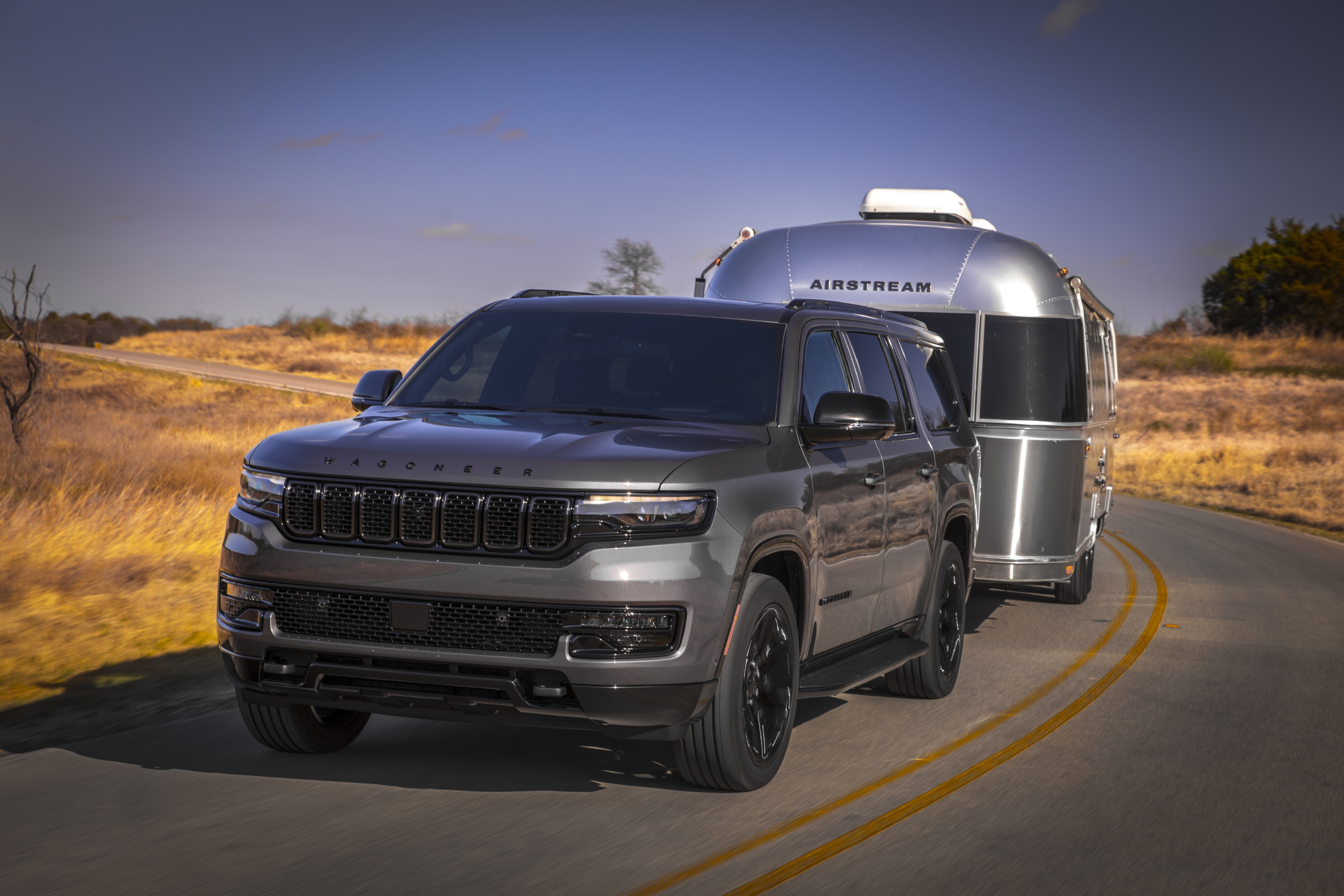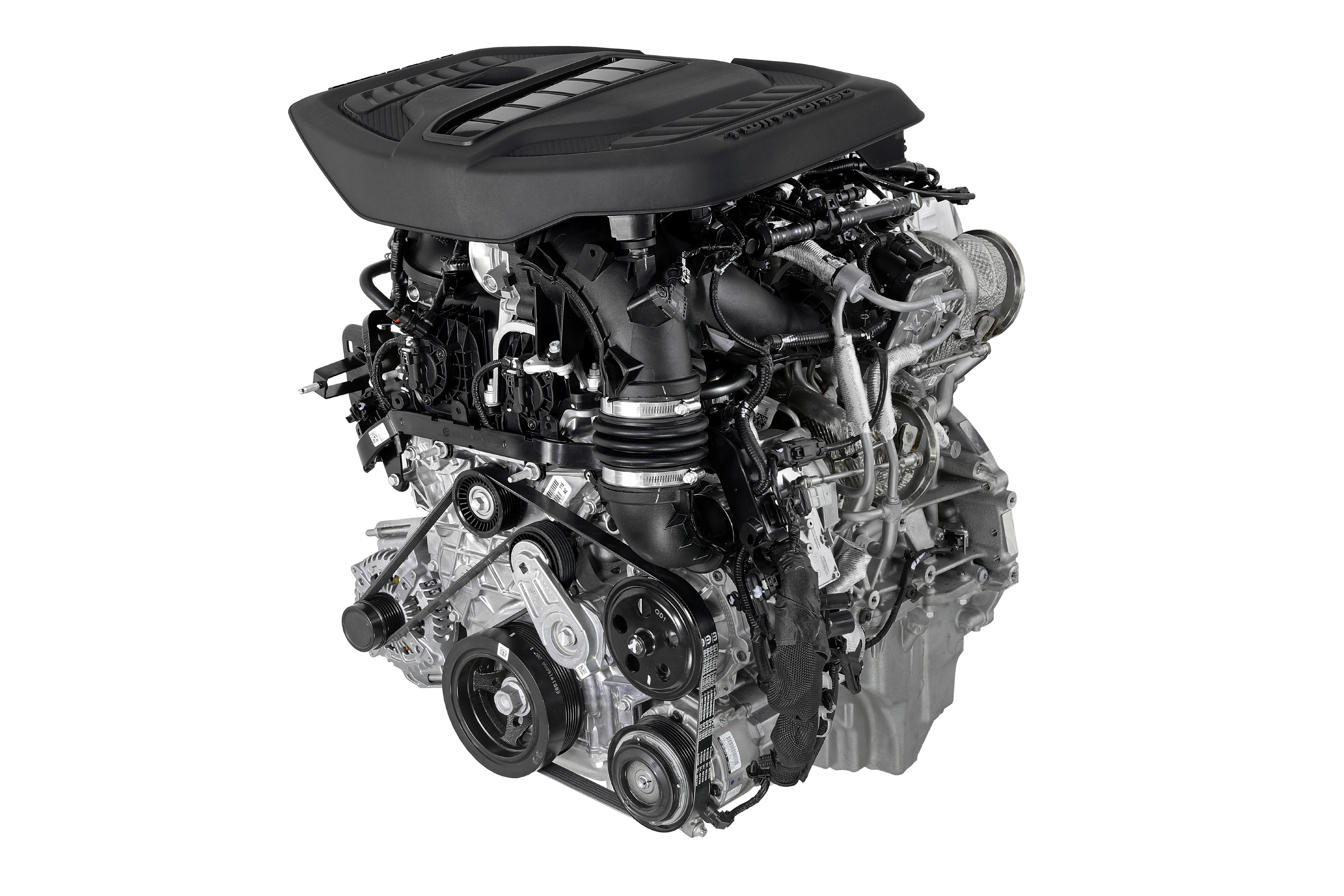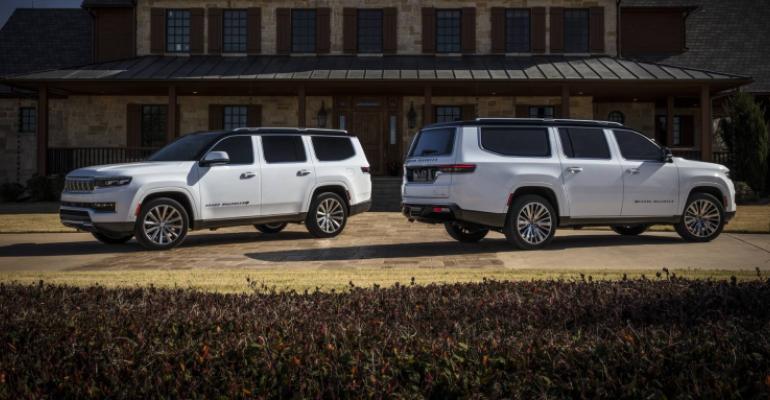BOZEMAN, MT – Say you’re Stellantis, and you’ve just very nicely redone your popular Grand Cherokee midsize SUV lineup with available 4xe plug-in hybrid and extended-length, three-row L versions. But you still want to take on General Motors’ Chevy Tahoe and Suburban, GMC’s Yukon and Yukon XL, Ford’s Expedition and others in the lucrative fullsize SUV segment, even including Cadillac’s full-lux Escalade and Lincoln’s line-topping Navigator.
So, you develop the all-new body-on-frame Wagoneer and high-line Grand Wagoneer for 2023, which (for some reason) are not badged as Jeeps but touted as the “premium extension of the Jeep brand.” And now you launch foot-longer extended L versions with even more passenger room (the 7 ins. [178 mm] of added wheelbase expands the cabin ahead of the rear axle) and cargo space, plus all-new Hurricane twin-turbocharged I-6 engines.
Why invest in all-new engines at this time of major conversions to BEVs? Because, while you intend 50% of your portfolio to be BEVs by 2030, the other half will need state-of-the-art ICEs.
“The new Wagoneer L and Grand Wagoneer L long-wheelbase models give our customers more,” says Jim Morrison, senior vice president and head of Jeep brand North America. “A more efficient and more powerful powertrain with the all-new Hurricane twin-turbo engines, and even more space, delivering best-in-class overall passenger volume, second-row legroom and cargo volume behind the third row, all while maintaining best-in-class towing capability of 10,000 lbs. (4,540 kg) and a rewarding driving experience that is confidence-inspiring.”

Helping to enable these large SUVs’ impressive ride, handling, towing and off-road capabilities are their very stiff yet comparatively lightweight structures, which use a lot of high-strength steel along with high-strength aluminum hood and doors and a composite liftgate. Their fully independent suspensions are double-wishbone (with composite upper and aluminum lower control arms) in front, multi-link in back. Coil springs are standard on Wagoneer L, while Quadra-Lift air suspension with electronically controlled semi-active damping is optional, and standard on Grand Wagoneer L.
Three Jeep 4x4 systems – Quadra-Trac I, Quadra-Trac II and Quadra-Drive II – are available, plus Selec-Terrain traction management and Selec-Speed Control. Selec-Terrain offers Auto, Sport, Snow, Sand/Mud and Rock settings, the latter raising the air suspension to its 10-in. (254-mm) max ride height and coordinating transfer case, differentials and throttle to optimize low-speed control. Selec-Speed (hill ascent and descent) Control allows drivers to maintain vehicle speed up and down steep, rugged grades without using throttle or brakes. And with up to 10 ins. of ground clearance, these stretch Wagoneers can ford up to 24 ins. (610 mm) of water.
![WS023_121WG[1].jpg](/sites/wardsauto.com/files/WS023_121WG1.jpg)
Features
No need to comment on design here except to say that these big SUVs look good to us inside and out, and their cabins are as upscale and roomy as they are quiet on the road (which is why the standard-length versions earned a 2022 Wards 10 Best Interiors & UX award) with a spacious third row and available seating for eight on all models. Front- and second-row captain’s chairs are available on Wagoneer L and standard on Grand Wagoneer L, and third-row access is eased by the second-row seat’s Tip n’ Slide power release function.
The Uconnect 5 system offers multiple connected features and services with good usability and (in Grand Wagoneer L) up to 75 sq.-in. (484 sq.-cm) of total screen area. Highlights include 10.1-in. (26-cm) and 12-in. (30-cm) reconfigurable touchscreens with split-screen capability; an available 10.25-in. (26-cm) passenger-side screen that can control navigation, device management and entertainment (including rear seat) as well as view the exterior vehicle cameras and available built-in Amazon Fire TV; five user profiles and a valet mode; simultaneous connectivity for two Bluetooth phones; Wireless Apple CarPlay and Android Auto; Alexa virtual assistant; TomTom navigation with predictive search, natural speak and live traffic updates; over-the-air (OTA) map updates and a 4G LTE Wi-Fi hotspot to connect up to eight wireless devices.
![WS023_001MM10l27th0ik82gsniafmra2htjb[1].jpg](/sites/wardsauto.com/files/WS023_001MM10l27th0ik82gsniafmra2htjb1.jpg) Grand Wagoneer L second-row passengers get 30 sq. ins. (194 sq.-cm) of total screen space and can watch the built-in Amazon Fire TV with access to thousands of movies, TV shows and apps. McIntosh high-zoot audio is standard on Grand Wagoneer L, available on Wagoneer L, and a rear-seat-monitoring camera available on Grand Wagoneer L enables the driver to quickly view the entire rear cabin and zoom in on each seat location.
Grand Wagoneer L second-row passengers get 30 sq. ins. (194 sq.-cm) of total screen space and can watch the built-in Amazon Fire TV with access to thousands of movies, TV shows and apps. McIntosh high-zoot audio is standard on Grand Wagoneer L, available on Wagoneer L, and a rear-seat-monitoring camera available on Grand Wagoneer L enables the driver to quickly view the entire rear cabin and zoom in on each seat location.
Among the claimed 120 standard safety features are adaptive cruise control with stop-and-go, automatic emergency braking with pedestrian and cyclist detection, active lane management, blindspot monitoring and rear cross-path detection. Available additional features include active driving assist, intersection collision assist, night vision with pedestrian and animal detection, drowsy driver detection, traffic sign recognition, surround-view camera and Park Sense automated parking system.
Hurricane Engines
Inline sixes are naturally smoother-running than fours or V-6s, which is one good reason BMW (and some others) still use them. Two levels of this new 3.0L straight-6 debut with these 2023 stretched L SUVs: A 420-hp, 468 lb-ft. (635-Nm) “420” version is standard in Wagoneer L, and a 510-hp, 500-lb.-ft. (678-Nm), high-output “510” version is standard in Grand Wagoneer. Both are said to deliver more power, more torque and better efficiency than most boosted 6-cyls. and naturally aspirated V-8s, including Stellantis’ current 5.7L and 6.4L V-8s. Both deliver that output through a TorqueFlite 8-speed automatic.
 By comparison, the “420” 6-cyl. in the Wagoneer L 4x4 is EPA rated at 16 mpg (14.7 L/100 km) city, 23 mpg (10.2 L/100 km) highway and 19 mpg (12.4 L/100 km) combined vs. the 5.7L V-8 in the (shorter, lighter) standard Wagoneer 4x4 at 15/20/17 mpg (15.7/12/13.8 L/100 km). And the “510” 6-cyl. in the Grand Wagoneer L rates 14/19/16 mpg (16.8/12.4/14.7 L/100km) vs. 13/18/15 mpg (18.1/13/15.7 L/100 km) for the 6.4L V-8 in the regular Grand Wagoneer, both with standard 4x4.
By comparison, the “420” 6-cyl. in the Wagoneer L 4x4 is EPA rated at 16 mpg (14.7 L/100 km) city, 23 mpg (10.2 L/100 km) highway and 19 mpg (12.4 L/100 km) combined vs. the 5.7L V-8 in the (shorter, lighter) standard Wagoneer 4x4 at 15/20/17 mpg (15.7/12/13.8 L/100 km). And the “510” 6-cyl. in the Grand Wagoneer L rates 14/19/16 mpg (16.8/12.4/14.7 L/100km) vs. 13/18/15 mpg (18.1/13/15.7 L/100 km) for the 6.4L V-8 in the regular Grand Wagoneer, both with standard 4x4.
Not surprisingly, these more efficient new inline sixes (which are short enough to package wherever V-8s fit) will find their way into other Jeep products and already are available in regular-length Wagoneers and Grand Wagoneers.
Among the state-of-the-art technologies Stellantis propulsion system engineers employed to deliver big-engine power and torque with improved efficiency (and earn 2022 Wards 10 Best Engines & Propulsion Systems recognition) are: twin low-inertia, high-flow turbochargers for rapid throttle response, plasma transfer wire arc (PTWA) spray-in cylinder bore coatings for ultra-thin, low-friction wear surfaces, high-pressure (5,075 psi/350 bar) direct fuel injection and an engine-mounted water-to-air charge cooler with a dedicated cooling circuit.
We drove a Wagoneer L and a Grand Wagoneer L on urban streets, freeways and challenging two-lanes near Bozeman, MT, and found them (as claimed) feeling smaller than they are. We would hardly call them nimble, but they are satisfyingly responsive, comfortable riding and whisper quiet, with good, crisp steering and strong, linear braking in all conditions.
Likely because of its lower vehicle weight, we subjectively judged the 420-hp Wagoneer L nearly as strong the 510-horse Grand Wagoneer L, and both feel at least as powerful as the V-8s we’ve driven in standard Wagoneers. On the negative side, given that each small turbocharger feeds just three of the six cylinders, our one complaint was more turbo lag than expected when stomping the gas to pass slower vehicles. And we saw just 16.5 mpg (14.2 L/100 km) after piloting the Grand Wagoneer L fairly aggressively for three hours. (Your mileage will vary.)
If you are Stellantis, you should feel proud that these big SUVs are as good as they are in every way – fully competitive, we believe, with all class competitors. And that your Jeep/Wagoneer lineup now seems complete. Priced some $3,000 higher than their regular-length stablemates, these are not inexpensive vehicles, but they should succeed as long as there is substantial U.S. demand for such large, body-on-frame SUVs.
![WS023_023WGlesidn4fle3gaeeiro71mjgqlg[1].jpg](/sites/wardsauto.com/files/WS023_023WGlesidn4fle3gaeeiro71mjgqlg1.jpg)


![WS023_050GWul17jk13f131jh5lei3aoh4kaf[1].jpg](https://www.wardsauto.com/sites/wardsauto.com/files/styles/article_related_thumb_standard/public/WS023_050GWul17jk13f131jh5lei3aoh4kaf1.jpg?itok=rOsS6uvc)


